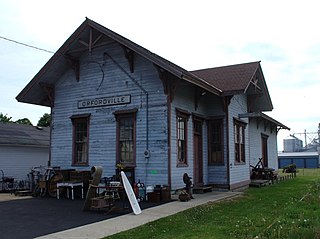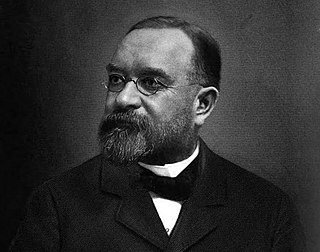
Patrick Cudahy Jr. ; March 17, 1849 – July 25, 1919) was an American industrialist in the meat packing business and a patriarch of the Cudahy family. He was also the founder and namesake of Cudahy, Wisconsin.

The Chicago, Milwaukee, St. Paul and Pacific Depot Freight House and Train Shed, now officially named The Depot, is a historic railroad depot in downtown Minneapolis, Minnesota, United States. At its peak, the station served 29 trains per day. Following decline, the station was closed and eventually adapted into various other uses.

Winona station is an Amtrak train station in Winona, Minnesota, United States. It is served by the daily round trips of the Borealis and Empire Builder. The station building was listed on the National Register of Historic Places in 2013 as the Chicago, Milwaukee & St. Paul Railway Station. The station is typically the second-busiest Amtrak station in Wisconsin.

The Chicago Great Western Railroad Depot is a historic railway station in the village of Elizabeth, Illinois, USA. It was built in 1877–78 and like many rural stations along the Chicago Great Western Railroad it was cast in Stick style. The building was listed on the U.S. National Register of Historic Places in 1996.

Charles Sumner Frost was an American architect. He is best known as the architect of Navy Pier and for designing over 100 buildings for the Chicago and North Western Railway.
Chicago and North Western Depot and variations may refer to the following stations used by the Chicago and North Western Railway:
Frost & Granger was an American architectural partnership from 1898 to 1910 of brothers-in-law Charles Sumner Frost (1856–1931) and Alfred Hoyt Granger (1867–1939). Frost and Granger were known for their designs of train stations and terminals, including the now-demolished Chicago and North Western Terminal, in Chicago. The firm designed several residences in Hyde Park, Illinois, and many other buildings. Several of their buildings are listed on the U.S. National Register of Historic Places.

The Chicago and Northwestern Railroad Depot is a railroad station located between Suffolk and Lowell Streets in Ironwood, Michigan. It was listed on the National Register of Historic Places in 1985.

The Orfordville Depot was built in 1886 by the Milwaukee and Mississippi Railroad and served as a de facto social center for the tiny community of Orfordville, Wisconsin for decades. In 1988 it was added to the National Register of Historic Places.

The Edgerton Depot is a historic railway station located at 20 South Main Street in Edgerton, Wisconsin. The station was built in 1906 to 1907 to serve the Chicago, Milwaukee, St. Paul and Pacific Railroad, also known as the Milwaukee Road; it replaced the city's original depot, which opened in 1853 with the railroad. Railroad engineer C.F. Loweth designed the station, which features a hipped roof, bracketed overhanging eaves, a red brick exterior with stone trim, and decorative brick quoins and keystones. The station was critical to the city's tobacco industry, which attracted customers from as far away as Europe; the railroad both shipped tobacco to larger cities and brought business agents to the city's firms. Passenger trains to the station, which were used both by residents and the aforementioned businessmen, primarily served routes to Milwaukee and Chicago. The station was remodeled in 1939, though rail travel in Edgerton had already begun to decline by this point; it fell even more significantly in the 1950s and 1960s, and the station closed in 1971.

John Plankinton was an American businessman. He is noted for expansive real estate developments in Milwaukee, including the luxurious Plankinton House Hotel designed as an upscale residence for the wealthy. He was involved with railroading and banking. The Plankinton Bank he developed became the leading bank of Milwaukee in his lifetime. He was involved in the development of the Milwaukee City Railroad Company, an electric railway.

William Plankinton was an American businessman, manufacturer, and industrialist. He followed in his father's footsteps in the meat packing and meat processing industry.

The East Wilson Street Historic District includes remnants of businesses that grew around two railroad depots a half mile east of the capitol in Madison, Wisconsin, starting in the 1860s. A cluster of the hotel and saloon buildings from this district are still fairly intact, in contrast to Madison's other railroad station on West Washington. In 1986 the district was listed on the National Register of Historic Places and the State Register of Historic Places in 1989.

The Milwaukee Road Depot in Madison, Wisconsin is a former railroad depot. It was built in 1903 and operated by the Chicago, Milwaukee, St. Paul and Pacific Railroad. It served numerous passenger trains, including the Sioux and Varsity, and was located next to a major yard, turntable, and roundhouse. The station was one of two Milwaukee Road stations in Madison, and was also known as West Madison station or West Madison Depot to avoid confusion with Franklin Street station on the east side of Madison. All Milwaukee Road passenger service in Madison was consolidated to this station with the closing of Franklin Street in 1952. The Milwaukee Road's service from Chicago to Minneapolis-St. Paul traveled through Milwaukee and central Wisconsin, bypassing Madison to the north. The railroad's competitor, the Chicago and North Western Railroad, offered direct service northwest to Minneapolis.

The Chicago and North Western Depot is a former railway station in Reedsburg, Wisconsin, which has been on the National Register of Historic Places since 1984. The station served the Chicago and North Western Railway along the Twin Cities 400 line for much of its life. It was built in 1906, and operated as a passenger station until closing in 1963. Currently, it houses the Reedsburg Chamber of Commerce and the headquarters for the 400 State Trail. The railway line, however, remains in use by Wisconsin and Southern Railroad.

The South Milwaukee Passenger Station is a historic railroad station located at 1111 Milwaukee Ave., South Milwaukee, Wisconsin. The station was built in 1893 for the Chicago & Northwestern Railway replacing a frame depot from 1885. Architect Charles Sumner Frost designed the Romanesque station. The depot, located on the east (southbound) platform, included ladies and gentlemen's waiting rooms, restrooms, a ticket office, freight office, train dispatcher's office, and two large rooms for baggage, express, and storage.

The Main Street Commercial Historic District is located in Jefferson, Wisconsin.

Madison station is a former railroad station in Madison, Wisconsin. The station served passenger and freight trains of the Chicago and North Western Railway (C&NW). Passenger service ended in 1965 and the passenger station and freight depot was bought by Madison Gas and Electric (MGE) and has been renovated to serve as offices. The station and freight depot are listed as contributing properties on the National Register of Historic Places East Wilson Street Historic District. The Chicago, Milwaukee, St. Paul and Pacific Railroad had tracks paralleling the C&NW and also had a nearby passenger station that outlasted the C&NW station as an active station by several years.

The Eau Claire station, otherwise known as the Chicago, St. Paul, Minneapolis & Omaha Railroad Depot was a historic railroad station located at 324 Putnam Street in Eau Claire, Wisconsin. The station was built in 1893 for the Chicago, St. Paul, Minneapolis & Omaha Railroad, a subsidiary of the Chicago and North Western Railway. The depot was designed by Charles Sumner Frost in the Richardsonian Romanesque style utilizing Lake Superior brownstone. Passenger service on the line was ceased in 1963.

The Neenah station, otherwise known as the Neenah-Menasha station or Chicago and Northwestern Railroad Depot is a historic railroad station located at 500 N. Commercial Street in Neenah, Wisconsin. The station was built in 1892 for the Chicago and North Western Railway. The depot was designed by Charles Sumner Frost in the Richardsonian Romanesque style. Passenger service on the line was ceased in 1971.




















